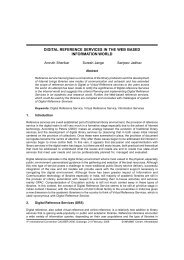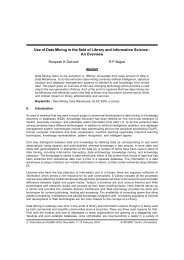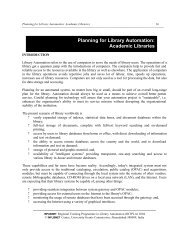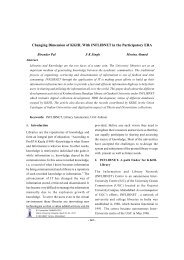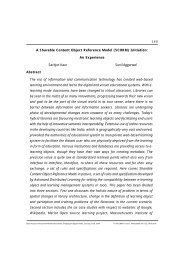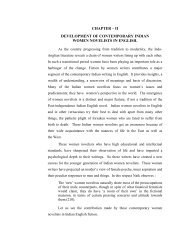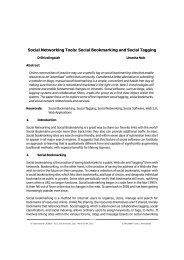INTERNET SERVICE PROVIDER FOR LIBRARY MANAGEMENT
INTERNET SERVICE PROVIDER FOR LIBRARY MANAGEMENT
INTERNET SERVICE PROVIDER FOR LIBRARY MANAGEMENT
- No tags were found...
You also want an ePaper? Increase the reach of your titles
YUMPU automatically turns print PDFs into web optimized ePapers that Google loves.
<strong>INTERNET</strong> <strong>SERVICE</strong> <strong>PROVIDER</strong> <strong>FOR</strong> <strong>LIBRARY</strong><strong>MANAGEMENT</strong>byMohan Das M K *Shet K C**ABSTRACTThe infrastructure for Internet Service for effective library management has beenanalyzed in this paper. The servers form a critical part of infrastructure for all libraryusers. The Internet Service Providers (ISP) all over the world use different types ofservers. In this paper an attempt has been made to see how to set up an ISP underdifferent classes with indication of cost for such infrastructure.Keywords: Internet Service Providers (ISP), Library Management - ISP* Librarian, KREC, Surathkal** Professor, Dept. of Comp. Engg., KREC, Surathkal0 IntroductionIn the current age of information explosion, Libraries form the most vital forum foreducation. This is more so in the field of Technical Institutions, given the pace ofdevelopment taking place all round the globe in the field of technical education ingeneral, libraries in particular.The research and developments in the Science and Technical area have evolved intomulti disciplinary domain, creating huge demand on library services. The conventionallibraries are ill equipped to meet this user demand and are often plagued by theinadvertent delay in the supply, and chain of information.The developments in the area of multi-media, computer net-working, huge storagedevices, high speed internet connectivity, Information highway, electronic sky writingetc. enable a user to have instant and economic accessibility to information of his/herchoice.It is an imperative for every organization particularly libraries of technical education toremain up-to-date with the latest advances in technology. Information Technology hasbecome a principal driving force for long term economic growth. By the advances inInformation Technology, say hardware, software, Tele-communications, networking,scanning technology, multi-media, the whole world has shrunk into a “Global Village”.By electronic proximity to various storehouses around the world, these libraries create
virtual worlds of information to the needy user. The multi-media storage conceptadopted in these libraries increases their utility and it is now imperative for every libraryof Technical Institution to get baptized into the Digital age.The challenges in the creation of such libraries are innumerable.World Wide Web made the Internet usage more popular among the users. Internet hasmade it possible for us to reach any people or access any information on the Cyber Space.The online service for library users need a powerful server either through Internet orIntranet. There are several Internet Service Providers (ISP) in the commercial arena. Witha slight modification we can configure management through Internet Service Provider.The year 1999 will go down in the history of Indian IT as the year of the private InternetService Provider. In the early 1999, there where as many as 300 aspirants to offer variousInternet-related services across the country. Although this number has dwindled down toless than 100 today, the ISP market promises much.The government has classified potential ISP providers into three categories.?? A National level ISP who can provide services across the country is a class ‘A’ ISP.?? If it limits its activities to a particular region or state then it is a class ‘B’ ISP.?? If the ISP focus only on a particular city, town or a part of a city then it qualifies asclass ‘C’ ISP.It is important to know what it takes to be an ISP in terms of building of theinfrastructure. There are number of vendors offering various solutions for prospectiveISPs in the country. It is even more interesting to know how much it costs to be an ISP.In the market there are a number of solutions that varies in terms of cost andconfiguration. However, there are few parameters that an ISP has to consider whileplanning infrastructure.?? The Servers: Servers form a critical part of infrastructure. In fact, ISPs worldwideuser different types of servers – from Intel-based ones to large number crunchingboxes from IBM or Sun based RISC architecture. The UNIX operating system is verypopular among the ISPs because of its stability and security features. However,smaller ISPs usually bet on the cost-effectiveness and simplicity of MicrosoftWindows NT. It is very common to have multiple servers or server farms formanaging different functions of an ISP.Some of the ISPs even look at a combination of servers running multiple operatingsystems. The servers store different software needed to manage the ISP network likebilling software, helpdesk etc.
?? Backbone connectivity: It is usually a leased line with pipe speeds ranging from64Kbps to 20 Mbps depending whatever VSNL\BSNL offers to the Vendors.?? Backbone router or switch: Externally circuit aspect of the infrastructure, especiallyfor Class ‘A’ ISP. Many Indian ISPs prefer to invest in backbone routers because theyare simpler to fit into a network design. However, the best solution is a Fast Ethernetor Gigabit Ethernet switch with Layer 3 and Layer 4 capability.?? Remote Access Connectivity: The options are to use an edge router or remote accessserver (RAS). The costs clearly depend on the number of ports.?? Software: Software ranges from basic operating system to the server software. AnISP also needs software for billing, help desk and managing the network.?? DOT line charges: The leasing costs of telephone lines from the BSNL.1 Class A ISPThe Class A- ISP is expected to target at least 20,000 to 40,000 users across the countryin the very first year. This is a very stiff target considering the fact that there will be atlast 7 to 8 major players in the market as competitions. The investment hence will behuge. As the number if users are expected to escalate over a period of time, scalability isthe keyword as far as the solution goes.?? The Servers: Almost all vendors will recommend multiple boxes of RISC\UNIXbased servers. Nevertheless, it is a known fact that many ISPs are considering or haveinvested into Windows NT based PC servers because of their lower costs. In addition,the costs on the server also depend on the storage. Since the ISP is also expected todouble up as Web content host, storage is also considered as important.Many ISP solution providers recommended separate storage centers for security andmanagement of data. RAID (Redundant Array of Inexpensive Disks) boxes, whichcould be configured to store at least 100 gigabyte of data, are recommended. The costof the servers will be anything between Rs.25 Lakh and Rs.100 Lakh depending onthe solution and data storage capabilities. It is not always necessary to have multiplecenters in all cities.?? Backbone Connectivity: The Class A- ISP should have at least two Mbps leased lineto start off. Once the number of users goes up, then higher bandwidth is necessary. Atwo Mbps pipe costs around Rs.34,00,0000/-.?? Backbone switch or router: A good backbone router will cost about Rs.4 Lakh.Again, a Layer 4 switch, which costs around Rs.1.25 Lakh, is the best bet. A Layer 4
switch gives the ISP flexibility to even control the data accessed by the user.?? Remote Access Connectivity: For a targeted user community of 20,000 a 1:50 ratiois recommended to start with and a ratio of 1:8 when the critical mark of 20,000 isreached. This implies roughly 2,500 RAS ports. The RAS ports could be as cheap asRs.7, 000. Apart from these, there is the cost of the modems. This implies roughly aninvestment of Rs.1.25 Lakh.?? Software: The software needed for the ISP could start as cheap as Rs.2 Lakh. Thisincludes the operating system, the Internet Server software and the software forbilling and helpdesk. At the same time, there are a number of freebies on the net, withwhich a little optimization becomes easy to use. There are also solutions fromvendors like IBM and HP where costs are as high as Rs.50 Lakh.?? BSNL charges: The line charges leasing will be as low as Rs.2, 000 per line andcould cost as much as Rs.5, 000. As you see, the total cost could be as low as Rs.2.25crore or as high as Rs.5 crore.Such a scheme is recommended large libraries like National library.2 Class B ISPA regional player, the class B ISP has to focus on providing solutions, which have aregional touch. The class B ISP has a target of at least 8,000 users.?? The Servers: The ideal option is low cost NT based servers, though, UNIXsolutions are also available. An investment of Rs.15 Lakh on the server will be ideal.?? Backbone connectivity: One Mbps line is good to start with. In smaller towns64Kbps or 128 Kbps will suffice.?? Backbone router: Here also the investment is not different from those of class AISP. The costs could be as low as Rs.4 Lakh.?? Remote Access Servers: Around 400 ports mean an investment of at least Rs.20Lakh.?? Software: The software costs can be as low as Rs.1, 00,000 (One Lakh). In case ofclass B service provider the solution will cost Rs.1.25 crore to Rs.2 crores.This is recommended for medium scale libraries like University/IIT/REC etc.3 Class C ISP
Class C ISP is a city or town based player. The target is around 2,000 users.?? The servers: A Pentium II server or low cost HP or Sun server. This cost could be aslow as Rs.2, 00,000.?? Backbone connectivity: 64 Kbps lease line is good enough to start off. Anotheroption is going for multiple ISDN (Integrated Services Digital Network) connectionas backup in case a line goes down.?? Backbone router: It is better to use a network switch than a backbone router.?? Remote Access Connectivity: At least 150 ports, which cost around fifteen Lakh.Apart from this the cost of the medium has to be considered.?? Software: The entire software cost including the helpdesk, billing and internalsupport will cost another lakh.The class C service provider can actually pick up a solution for as low as Rs.25, 00,000(Twenty-Five lakh). This is good for low volume libraries.4 ConclusionThe KREC Library is not left behind and attempts have been made, time to time to adoptmodern technology.A decade back, this library computerized its in-house activities, catering to the needs ofusers. By acquiring commercial CD-ROM data bases on COMPENDEX, INSPEC theyare made available in the Library. Now, planning to extend Internet service, we canaccess databases on various topics across the world.This library is already using ERNET and now entered into MOU with DELNET, whereinnation wide information on Books, periodicals, article database. Inter-Library facilitiesand other so many advantages can be made available. This library is equipped with directleased line for 64 Kbps Internet connections.The 21 st century is fully geared to takeoff on-line launch pad. The Govt. of India passedcyber laws act in the parliament in the year 2000. There will be a great fillip for the onlineactivities in India.?? The selling and buying of books have already become popular by several websites.One good example is Amazon.com.?? The library management is bound to revolutionize in this decade.In this paper, we have presented cost analyses of setting up of Internet Service Provider
in general and Library management in particular.5 Bibliography1. Expense Computer. October 15, 2001.2. Winkler (IRA S) (ed.). Internet Security, Tech Media, Professional reference, 2 nded.3. Mantra on-line, New Vol., Information Brochure.4. Satyam Infoway, Information Brochure.5. Ascent, Times of India, 28/11/2001.6. Web vision, Indian Express group, September 2001.7. SEETHARAMA (S) and AMBUJA (R). Collection development in the Digitalenvironment. Information Studies. 7, 3-4; 2001. p 153-166.8. TENOPIE (C). Internet issues in reference. Library Journal. 20, 16;1995. p 28-30.9. HARRY (M K) and LISA (D P). Internet as a source of academic information.Information Technology & Libraries.1 Mar, 2000. p 11-16.





